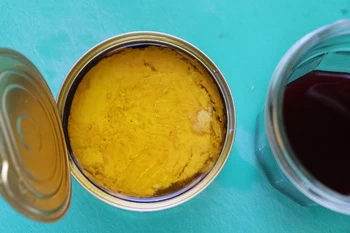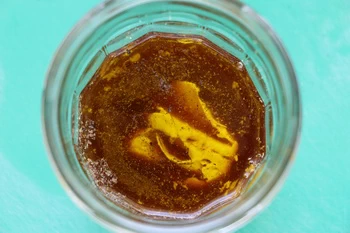This site uses only a few technical cookies necessary for its operation. By continuing to browse, you accept their use.
To find out more...
To find out more...
Preservative oil, an asset for taste

When you prepare a dish using an ingredient that has been preserved in fat, for example a springtime mixed salad with tuna in oil or sun-dried tomatoes, you're probably going to make a french dressing (vinaigrette) next.
In that case, why not use the preserved oil from the tuna or tomatoes?
In that case, why not use the preserved oil from the tuna or tomatoes?
7,635 5/5 (14 reviews)
Keywords for this post:SauceOilTaste recoveryEconomicalFatStorageLast modified on: June 5th 2024
Preservative oil, an asset for taste
It's not easy, or rather it's not something you think about very much, but it's a shame to throw away the oil used to preserve tuna or tomatoes, because it's naturally perfumed with whatever's been preserved in it.
And this taste, these aromas, will then be transmitted to your future preparations.
To take the example of the tuna in oil and the vinaigrette sauce for the salad, you proceed as usual for your salad, but when you add the tuna you collect the oil in a bowl or small jar.
Add vinegar, mustard, salt and pepper, mix well and your tuna-flavoured dressing is ready.
Just about anything that can be preserved in oil (fish, vegetables, cheese, etc.) can be used in this way, not just in a sauce, but as a cooking fat, for example.
Grill tomatoes in a little rosemary oil with cubes of feta cheese, for example, and you'll be amazed at the results.
So far, we've only talked about oil, but this applies to virtually all preservative fats.
In the same spirit, another example: roast potatoes in a little rillettes fat, and enjoy the resulting taste, in addition to the crispness of the roasted potatoes.
To sum up: don't necessarily throw away the fat used to preserve your food - it can often be used to accompany a recipe, or in cooking.
And this taste, these aromas, will then be transmitted to your future preparations.
To take the example of the tuna in oil and the vinaigrette sauce for the salad, you proceed as usual for your salad, but when you add the tuna you collect the oil in a bowl or small jar.
Add vinegar, mustard, salt and pepper, mix well and your tuna-flavoured dressing is ready.

Just about anything that can be preserved in oil (fish, vegetables, cheese, etc.) can be used in this way, not just in a sauce, but as a cooking fat, for example.
Grill tomatoes in a little rosemary oil with cubes of feta cheese, for example, and you'll be amazed at the results.

So far, we've only talked about oil, but this applies to virtually all preservative fats.
In the same spirit, another example: roast potatoes in a little rillettes fat, and enjoy the resulting taste, in addition to the crispness of the roasted potatoes.
To sum up: don't necessarily throw away the fat used to preserve your food - it can often be used to accompany a recipe, or in cooking.
Lasts posts
Butter vs. grease
We often read in a recipe where a pastry is put into a mould that, just before pouring, the mould should be buttered or greased. But what's the difference between these 2 terms?December 1st 20256895
Getting out of the fridge early
Very often when you're cooking, you need to take food or preparations out of the fridge, to use them in the recipe in progress. There's nothing tricky about this: you just take them out of the fridge and use them, usually immediately, in the recipe. But is this really a good method?November 24th 20259705
Who's making the croissants?
When you look at a bakery from the outside, you naturally think that in the bakery, the bakers make the bread, and in the laboratory, the pastry chefs make the cakes. It's very often like that, with each of these professions having quite different ways of working, but sometimes there's also one...November 23th 2025872
Oven height
When we put a dish or cake in the oven, we naturally tend to put it on the middle shelf, and that's what we usually do. But in some cases, this position and height can be a little tricky, so let's find out why.October 8th 20252,4775
The importance of sieving
In recipes that use a fine powder (flour, powdered sugar, etc.), you'll often see the advice to sift before using it. To sift is to pass the powder in question through a sieve (a very fine strainer) before incorporating it into your recipe. It's often advice, but is it really useful?September 3rd 20257,3503
Other pages you may also like
Different kinds of pastry and dough
When cooking in general, and particularly in baking, we can make and use many different kinds of pastry and dough. All built on the same "base": flour - a powder to which we add fat, liquid or both to produce the dough which is then cooked. .November 6th 2012111 K 14.0
When should I change my knife?
I already spoke to you in a previous post about knives, those without which nothing is possible (or almost) in the kitchen, so I'm going to come back to them a bit and try to answer the question "When should I change my knife?November 2nd 201715 K4.7
Coarsely chopped herbs
Although we are in the middle of winter as I write these lines, you should not hesitate to make salads at this time, it is actually quite simple, rather fast, and so pleasant. A while ago, I already told you that a salad is a salad, but a salad with herbs is immediately something much better:...January 9th 202114 K4.9
Should asparagus really be cooked in bunches?
You'll probably read recipes here and there explaining how to cook asparagus "en botte", i.e. in a small package (the famous "botte"). Is this really the right way to cook asparagus?May 22th 20247,7225
A few tips on homemade ice cream
If you make ice cream at home, which is a very, very good idea, you'll find a few tips and tricks in this article that should make your life easier. Combined with the site's ice cream recipes, they'll help you improve your production, to the delight of everyone around you, children first.August 11th 20248,3845
Post a comment or question
Follow this page (as 3 people already do)
If you are interested in this page, you can "follow" it, by entering your email address here. You will then receive a notification immediately each time the page is modified or a new comment is added. Please note that you will need to confirm this following.
Note: We'll never share your e-mail address with anyone else.
Alternatively: you can subscribe to the mailing list of cooling-ez.com , you will receive a e-mail for each new recipe published on the site.









